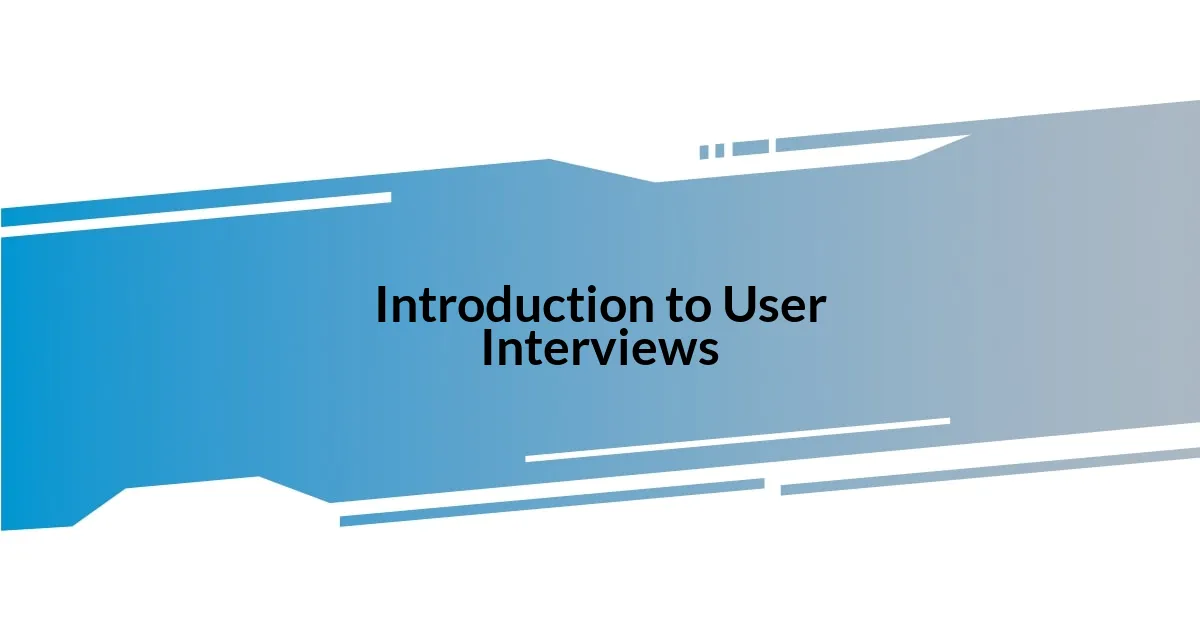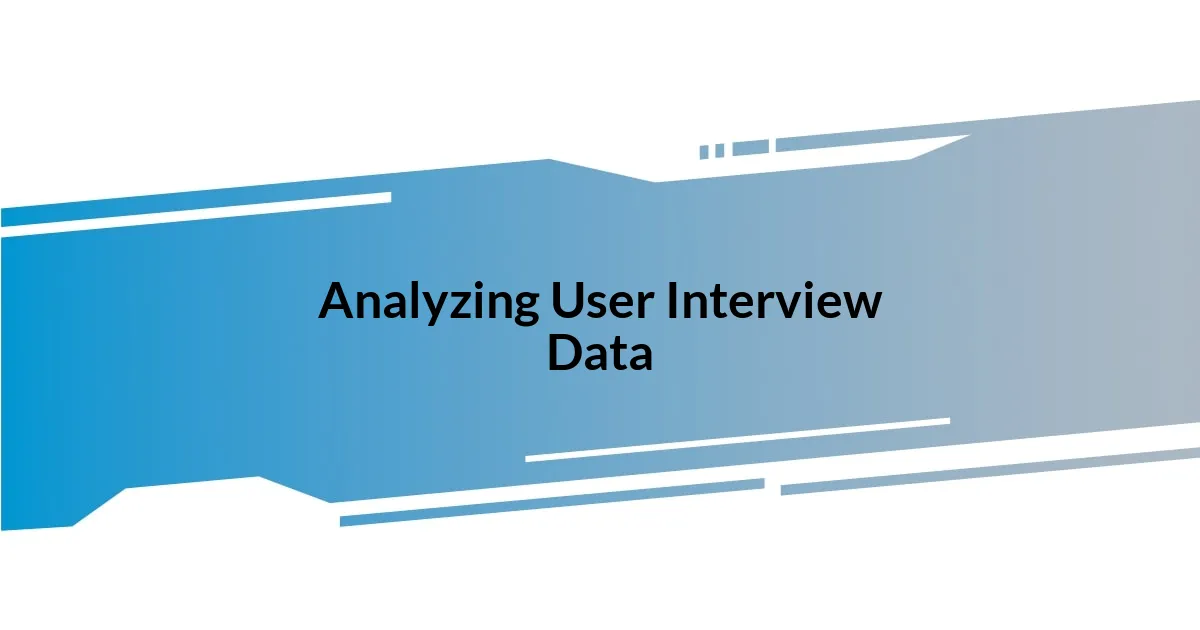Key takeaways:
- User interviews reveal deeper insights into user needs and motivations, transforming product understanding and development.
- Creating a comfortable environment and asking open-ended questions enhances the quality of feedback and user engagement.
- Implementing user feedback, even in small adjustments, can significantly improve the user experience and build trust and loyalty.
- Reflecting on the interview process fosters empathy, encouraging a connection to user stories and experiences, which guides actionable strategies.

Introduction to User Interviews
User interviews are a powerful tool for gaining insights directly from the people who matter most—your users. I remember my first interview; I was nervous, but as soon as I started asking questions, I realized how much people want to share their experiences. Isn’t it incredible how a simple conversation can unveil hidden needs and preferences?
When I sit down for an interview, I feel like I’m on a treasure hunt. Each response leads me closer to the gems of insight that can shape products and services. One time, I asked a user about their biggest pain point, and their honest feedback led to a pivotal change in our design. Have you ever discovered something unexpected that completely reshaped your understanding of a problem?
These interviews not only provide valuable information, but they also build empathy for users. Hearing their stories and frustrations allows me to understand their world better. It’s a collaborative experience, fostering a connection that extends beyond data collection. What insights have you gained from connecting with your users?

Importance of User Insights
Understanding user insights is crucial for any successful product or service. They reveal not just what users want but also the ‘why’ behind their needs. I remember a time when I misunderstood a feature’s importance until a user explained their daily struggles. Their perspective transformed my approach—suddenly, I viewed our product through their eyes, which was illuminating.
User insights also help prioritize features based on real-world applications rather than assumptions. Once, while analyzing feedback from interviews, it became clear that a minor feature we planned to enhance was significantly impacting user satisfaction. This newfound perspective allowed our team to pivot and focus on what really mattered. Have you ever been surprised by which features users truly valued?
Moreover, tapping into user insights fosters a culture of continuous improvement. When users feel heard, it builds trust and loyalty. I recall a project where regular interviews kept the lines of communication open with our audience. The rapport we developed directly influenced our iterations, leading to a more refined product that truly resonated with its users.
| User Insights | Traditional Research |
|---|---|
| Focuses on user needs and emotions | Relies on quantitative data |
| Encourages direct feedback and interaction | Uses surveys and analytics |
| Builds empathy and understanding | Often misses the user context |

Preparing for User Interviews
Preparing for user interviews can feel daunting, but I find that a little preparation goes a long way. I always remind myself to clarify my objectives before diving in. Understanding what specific insights I seek helps keep my questions focused and relevant. For instance, before one particularly revealing interview, I jotted down key themes I wanted to explore. This not only streamlined the conversation but also opened the door for deeper dialogue.
Here are some practical steps I take to prepare:
- Define the Objectives: Clearly outline what you want to learn from the interview.
- Select Participants: Choose users who align with your target demographic and have relevant experiences.
- Draft Questions: Create open-ended questions that encourage conversation rather than yes or no answers.
- Choose the Environment: Make sure the setting is comfortable and conducive to sharing.
- Practice Active Listening: Prepare to listen more than you speak; this is where the real insights often emerge.
I find that these steps not only help in gathering valuable information but also ease my nerves, steering the focus towards a relationship-building conversation rather than just an interview. It’s in those relaxed moments that I often hear the most poignant insights.

Conducting Effective User Interviews
Conducting effective user interviews requires a blend of empathy and curiosity. I’ve learned that creating the right atmosphere is essential. Once, I hosted an interview in a cozy café rather than a sterile conference room. The relaxed environment encouraged the user to share more openly, leading to revelations I hadn’t expected. Isn’t it fascinating how the setting can influence the depth of insight gained?
Another key aspect I prioritize is asking open-ended questions. I remember a time when I posed a seemingly simple question about daily challenges. The user began recounting a story about a frustrating experience with our product that I had never considered. This experience reinforced the importance of letting users express themselves fully, revealing insights that wouldn’t have surfaced through yes-or-no questions. What hidden gems of knowledge might be waiting just beyond the surface of our well-crafted inquiries?
Finally, I find that active listening is crucial during interviews. It’s tempting to think ahead to the next question, but truly engaging with the user allows for organic conversation. In one memorable session, I was so engrossed in a user’s account of using our product during a family vacation that I almost forgot to take notes! That emotional connection not only deepened my understanding but also fostered trust, making users feel valued and heard. How often do we take the time to really listen to our users?

Analyzing User Interview Data
Analyzing data from user interviews can be an eye-opening experience. After each session, I find myself sifting through notes and recordings, eager to capture the essence of what users shared. I vividly recall one instance where common themes emerged unexpectedly. As I dissected the feedback, I noticed several participants expressed frustration with the same aspect of a feature I thought was straightforward. This realization hit home; it was a powerful reminder that our assumptions about users often don’t align with their experiences.
Once I’ve gathered insights, I like to look for patterns and trends. Creating visual aids, such as charts or affinity diagrams, is something I’ve found incredibly useful. During a project last year, I compiled user quotes that aligned with specific pain points. As I arranged those quotes, an overwhelming narrative began to form. Seeing everything displayed visually not only clarified the findings but also sparked new ideas for solutions, making me feel more connected to the users’ journeys.
The real magic happens when I translate those insights into actionable strategies. For instance, after analyzing user feedback, I collaborated with my team to prioritize updates based on the most pressing user needs. I often wonder, how can we make sure that our passionate ideas don’t overshadow the voice of the user? Reflecting on that keeps me grounded, and I strive to ensure each decision is rooted in those authentic insights. Embracing this analytical approach not only refines our product but also deepens my empathy for our users.

Implementing User Feedback
Implementing user feedback is where the real transformations begin. Sometimes, after dissecting interviews, I feel a sense of urgency to act on what I’ve learned. In one project, users emphasized that a feature was confusing. I gathered the team for a brainstorming session, and we decided to overhaul that feature completely. It was exhilarating to know we were crafting something better based on real user pain points. Have you ever felt that rush when translating feedback into concrete changes?
I often find that even small tweaks can have a significant impact on the user experience. For example, a user once pointed out that our onboarding process took too long and felt overwhelming. After some discussion, we streamlined the steps and added tooltips for guidance. The gratifying response from users confirming that the process felt lighter and more intuitive reminded me that the smallest adjustments can ripple through the entire user journey. Isn’t it incredible how listening to users can unlock solutions so simply?
At times, though, incorporating feedback can be a balancing act. I recall when users loved a particular feature, yet it presented complexities for our development team. The challenge was to maintain the essence of what users loved while simplifying the underlying architecture. Engaging in open discussions with both users and developers helped find common ground. How do we navigate these sometimes conflicting perspectives? It’s through collaboration and empathy that we can create a product that resonates beautifully with everyone involved.

Reflecting on the Interview Process
Reflecting on the interview process always brings back vivid memories of the connections I formed with participants. I remember one interview where a user shared a deeply personal experience related to our product, and it struck a chord with me. That moment of vulnerability reminded me that interviews aren’t just about gathering data; they’re an opportunity to understand real lives behind the feedback. Have you ever felt that rush of empathy as someone opens up? It certainly solidifies the importance of actively listening.
I also discovered that the environment we create during these interviews plays a crucial role. Once, I opted for a cozy, informal setting, and the conversation flowed effortlessly. Participants shared their thoughts candidly, and I even ended up learning about their daily routines, which directly impacted how they use our product. It made me realize that a relaxed atmosphere can unlock insights that are often missed in more structured environments. Isn’t it fascinating how a change in setting can reshape the quality of feedback we gather?
As I review the interview recordings later, I can’t help but feel a mix of excitement and responsibility. There’s a weight to their words; they’re not just anecdotes but direct insights into what works and what doesn’t. I often ask myself, how can I do justice to the stories I’ve heard? This reflection urges me to distill their experiences into actionable strategies that truly reflect their needs. Each interview serves as a reminder that our users trust us with their stories, and it’s my job to honor that trust.